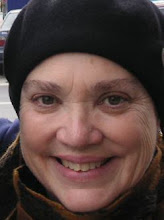Lately I seem to have been running into felting situations
that involve using resists to make felt pockets. I have done this in the past to put an
actual pocket into the side of a purse for instance. But you can also use the pocket to make a
3-dimensional shape on the surface of the felt.
The pocket doesn’t need to go in, it can protrude out.
I can’t remember when I saw my first hat with interesting
telescoping projections coming from it.
It was probably in the 80’s or early 90’s at one of the international
felting conferences. On a closer look,
these telescoping projections were sometimes made as pockets placed into the
side of the hat. Other times they were made
from large points on the top of the hat.
But in each case, the fabric used for the shaped projections wasn’t
essential to the fit of the hat. It was
an auxiliary form.
When you have a pocket coming off a surface, you have a lot
of extra felt fabric that you can manipulate so that you don’t distort the
actual base felt. You can scrunch it up;
stitch it into interesting pleated shapes; or put marbles or rocks into the extra
fabric and wrap rubber bands around them.
If this is done at prefelt stage, you can continue to full the felt and
the shapes will probably felt together. This
is a type of resist fulling, with the wool retaining its convoluted shapes
after the felting is complete and the item is dried.
You can also do this shaping after the felt is totally
completed. If allowed to dry in the
shape, the wool will stay that way until it is dampened and left to dry in
another shape.
When Julie Williams traveled around North America in 2006,
she taught many people how to make lovely roses by twisting a square pocket
that was protruding off the projects we were making. I made a purse with roses on the front and
back.
Recently,
I was in a workshop with Irit Dulman and in that workshop we also used
decorative pockets to make interesting surface textures. Here is my sample and a purse I made in that
class.


Just this last weekend, I took a workshop with Pam MacGregor. In that workshop, she again showed us how a way to make pockets and manipulate the extra fabric into creating an interesting bas-relief surface. I didn't have a chance to do this in class, so I started experimenting with it when I got home. These folded forms were very reminiscent of the ones I remember seeing on the hats in the 80's and 90's.
When I add pockets to a surface, I like to make the pockets separately and then attach them. I don't have photos of the process I used with the first one I made. I'll try to explain it. It had a cone shaped resist. I felted around the resist but left the bottom area unfelted - dry and fluffy. I then slit a piece of prefelt and inserted the resist. Here are some drawings to try and show it.
Cone Shape
Felt Covered Template with Non-Felted Fluffy Fiber on Bottom
I Inserted the Resist into the Hole that was Cut in the Prefelt Base.
(With the Fluffy Fiber Extending Out on Both Sides of the Prefelt.)
Here is the resulting sample. I was unhappy with the way the base felt was distorted. Notice the curved outside edges. It took a lot of work to get it somewhat straightened out. I decided to try something else on the next one.
Last year, I had seen a wonderful hat on this site: http://www.livemaster.ru/topic/48627-mk-po-shapochke-s-obemnymi-elementami-chast-1-pochemu-u-zajtsa-takie-dlinnye-ushi
Yana Volkova had done this tutorial on how to make a cute hat with a telescoping circle on the top of it. In the tutorial, which has 4 parts, Ms. Volkova made the cone separately, like I do. Then she laid the folded and shaped cone onto the hat in progress and felted it down. So it was round when it was felted down and it didn't distort the base. I decided to try this approach.
This is the felted cone with fluffy end.
To make the telescoping effect, I folded the cone inside and crimped the fold with my fingers.
Then I folded the cone the other direction.
I folded it in again.
I continued doing this, folding the cone in and out.
This is what it looked like after the final folding. The fuzzy edges were ready to attach to the prefelt base.
Here is the folded cone, laid on the prefelt. The fuzzy edges of the cone were covered with some more fiber to help them hold down.
Because the cone shape was laid over the flat base, it was difficult to felt its back side. So I cut down into base and revealed the back side of the cone. Then I could do some more felting and shaping easily. The whole thing came out pretty well. Not as much distortion as when the cone was placed into the slit.
Here is the folded, telescoping cone after felting. In the photo, I was shaping with the edge of a wooden butter knife.
I was quite happy with how this version of the cone came out. I will definitely try this again in the future. Especially since bas-relief sculptural pockets seem to be a recurring technique in my life.









.jpg)




















